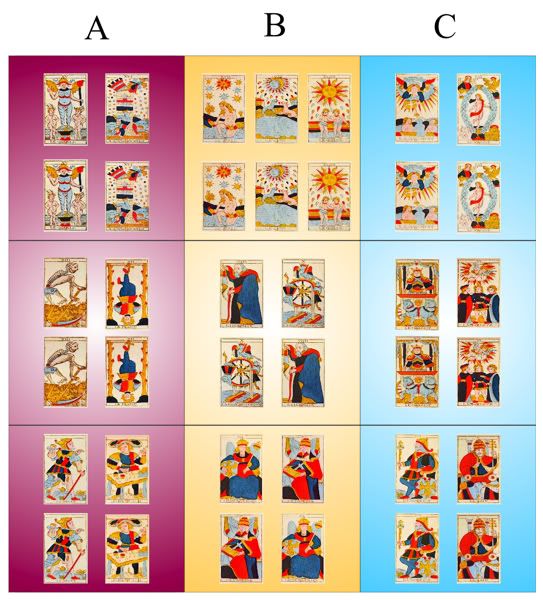Rosanne said:
Within their group how does the image portray it's position? I think for example as in the Visconti hand painted cards, they have not found one example of the Devil and the Tower- considered lost. How about 'never there'?
The GRINGONNEUR deck (mid 1400's) is early enough to make a FULL 22 trump set, right from the games origin, a viable possibility I reckon, as it has a surviving 'Tower' card. Personally I believe the 'hellish' nature of the Devil and Tower led some pious Catholic grandmas to remove and destroy the cards from many decks.
Rosanne said:
In uncut sheets of Italian tarrocchi cards,(1490 -1510 circa) that have the cards numbered- there is something quite different.
The World is unnumbered.
Justice is in position 20
Judgement is in Position 19
Strength is at position 9
Lovers is 8, Temperance is 6, Sun is 17, Hermit 11 etc. Papesse is 3.
There are cards that are the same card as is accepted now. 1 Bateleur, 10 is W.O.F., Hanged Man is 12, Le Pape is 5, Emperor is 4.
So this order does not fit with the same allegorical idea because Justice has moved out of it's group and is now with Star, Moon etc.
That's a great example of why I say,
"san virtues". The virtues are actually
outside the main allegory. They do not represent things or situations like the other cards, but
how we should behave in the given situation -
be fair, be brave, be moderate! That's why they seem so random and varying from region to region. We can deduce this since the virtues
alone move about in this way in the various historical orderings (although mainly three basic 'virtue' patterns are common). None of the other cards move more than one or two positions (mainly the switching of Love/Chariot, Time/Fortune, and the Papesse's rank). So the basic structure (without the virtues) is highly consistent.
I'm assuming the "uncut sheets' you are referring to are the so-called
Dick Sheets. With the virtues set aside, the basic structure of the trumps is for all practical purposes the same. (Dick Sheet is top, Milanese order bottom).
Before any explanations on the different 'virtue' orders can rationally be attempted, the main allegory should be understood.
Rosanne said:
I am on a different track to the imges themselves- how they portray their position- not their group.
What about it was just a group from 0- 14,18,20,22 -like one, two, buckle my shoe, three four knock at the door type of thinking?
There are many threads about looking at allegory as a way to understanding the message. How about we look at the position- given by the image to see what the message is?
~Rosanne
I'm not sure I follow you here. Shouldn't a set of allegorical images best be understood by the allegories the images are portraying? Say Father Time. Regardless of his position or what number he is given, we know what the card represents, right? Most of these images are understandable even in our era. Death is death, Love is love, the Pope is a Pope, the Emperor is an Emperor, etc.. Position won't change these basic meanings.
A few images are unfamiliar, say the Papesse, or the Tower. Here we need to do some research.
A card like the Papesse - a woman with a Papal crown has been shown to represent several things over the years, The Church or Faith, heretics like Pope Joan, the false religion of Catholics (by later Protestants). Here we need to consider not only the image, but how it is being used - its position in sequence, the other cards in the group, and how the three groups relate. So while the 'position' in the sequence is important to make an educated guess, I don't think any mystical or symbolic meaning based on the 'numerology' of the number 2, or the number 4, and so on, will answer the question correctly. Yet by looking at the various sequences,
Fool-Juggler-Papasse-Empress-Emperor-Pope
or,
Fool-Juggler-Empress-Papesse-Emperor-Pope
or,
Fool-Juggler-Empress-Emperor-Papesse-Pope
...then we can make a better guess about what the Papesse really means, and what the overall group means, and what the 22 cards overall message is. I don't think the numbers on the cards mean anything beyond an indication of their position in the sequence. But I've been wrong before... and hopefully learned from my mistakes. (Took me awhile to realize that strippers, despite their many 'charming' attributes, are probably not long-term relationship material.

)




